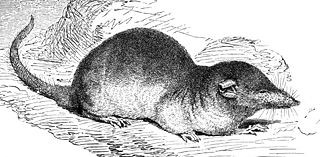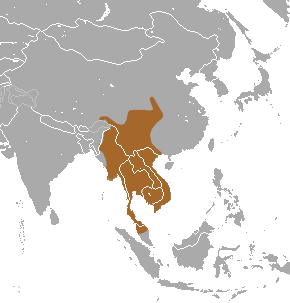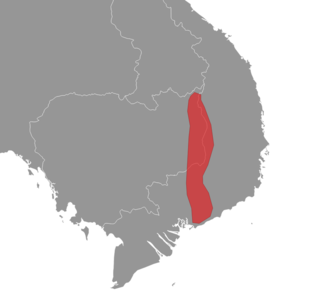
Shrews are small mole-like mammals classified in the order Eulipotyphla. True shrews are not to be confused with treeshrews, otter shrews, elephant shrews, West Indies shrews, or marsupial shrews, which belong to different families or orders.

The white-toothed shrews or Crocidurinae are one of three subfamilies of the shrew family Soricidae.

The genus Crocidura is one of nine genera of the shrew subfamily Crocidurinae. Members of the genus are commonly called white-toothed shrews or musk shrews, although both also apply to all of the species in the subfamily. With over 180 species, Crocidura contains the most species of any mammal genus. The name Crocidura means "woolly tail", because the tail of Crocidura species are covered in short hairs interspersed with longer ones.

The Asian gray shrew is a species of mammal in the family Soricidae. It is found in Bhutan, Cambodia, China, India, Laos, Malaysia, Myanmar, Nepal, Pakistan, the Philippines, Thailand, and Vietnam. It is one of the commonest species within its range and the International Union for Conservation of Nature has assessed its conservation status as being of "least concern".

The Southeast Asian shrew is a species of mammal in the family Soricidae. It is found in Cambodia, India, China, Laos, Malaysia, Myanmar, Thailand, and Vietnam.

The bicolored shrew or bicoloured white-toothed shrew is a species of mammal in the family Soricidae. It is found in eastern, central and southern Europe and in western Asia. It is a nocturnal species and feeds on insects and other small creatures. Several litters of young are born during the warmer months of the year in a nest of dry grasses in a concealed location.

The swamp musk shrew, or musk shrew, is a species of mammal in the family Soricidae. It occurs in Angola, Botswana, Democratic Republic of the Congo, Mozambique, Namibia, South Africa, Eswatini, Zambia and Zimbabwe. Its natural habitat is swamps, and it is a common species in suitable habitats, with the International Union for Conservation of Nature listing it as being of "least concern".

The Ugandan musk shrew is a species of mammal in the family Soricidae. It is found in Uganda, the Democratic Republic of Congo and the Central African Republic. Its range, population size and habits are poorly known.

The black-footed shrew is a species of mammal in the family Soricidae. It is endemic to northern and central Sulawesi, Indonesia where it lives on the floor of the tropical forests. The International Union for Conservation of Nature has assessed its conservation status as being of "least concern".

The African giant shrew is a species of white-toothed shrew. It also is known as, Mann's musk shrew, Euchareena's musk shrew, or Olivier's shrew. It is native to Africa, where it has a widespread distribution and occurs in many types of habitat. Its natural habitats are subtropical or tropical dry forest, subtropical or tropical moist lowland forest, subtropical or tropical moist montane forest, dry savanna, moist savanna, arable land, rural gardens, urban areas, and heavily degraded former forest. In the Nile Valley it is found near human habitation, where it is considered to be a pest. It is a common species and is listed by the International Union for Conservation of Nature as being of "least concern".

The Sulawesi white-handed shrew or Temboan shrew is a species of mammal in the family Soricidae. It is endemic to the island of Sulawesi in Indonesia. It is a fairly common species and the population seems stable so the International Union for Conservation of Nature has assessed its conservation status as being of "least concern".

Whitaker's shrew is a species of mammal in the family Soricidae. It is found in Western Sahara, Algeria, Morocco, Tunisia. Its natural habitats are subtropical or tropical dry shrubland, rocky and sandy coasts. It is a fairly common species and the International Union for Conservation of Nature has rated its conservation status as being of "least concern".

Crocidura phanluongi is a species of shrew in the genus Crocidura from southern Vietnam and nearby Cambodia. It is a somewhat small, gray shrew with an ecologically diverse distribution.
The Chinese white-toothed shrew is a species of mammal in the family Soricidae.

Crocidura sapaensis is a species of white-toothed shrew native to northern Vietnam. It was first described in 2013 and its specific name derives from the Sa Pa where it was discovered.
Crocidura kegoensis, also known as the Ke Go shrew or Ke Go white-toothed shrew, is a species of shrew in the genus Crocidura described in 2004. It is smaller than other Crocidura species known from Vietnam, brownish-grey in colour with black markings on the muzzle. Its hair is short. The holotype was found in the Ke Go Nature Reserve, in Vietnam's Ha Tinh province, at an altitude of about 200 m.

The Indochinese shrew is a species of white-toothed shrew native to Southeast Asia. It was first identified in 1922 by Herbert C. Robinson and C. Boden Kloss. The species is often taxonomized as a subspecies Horsfield's shrew, but bears a different range, occurring in Myanmar, Vietnam, and the Yunnan province of China. C. indochinensis is on the smaller end of shrews, with dark brownish gray fur and a long, slender tail.
The Phu Hoc shrew is a species of white-toothed shrew native to the island of Phú Quốc, Vietnam. The species was first described by Abramov et al. in 2008. The species' haplogroup is most closely related to the Southeast Asian shrew and C. dracula.
The Sanetti shrew or Bekele's shrew is a species of mammal in the family Soricidae. It is endemic to Ethiopia.
Sokolov's shrew is a species of mammal in the family Soricidae. It is endemic to Vietnam.














